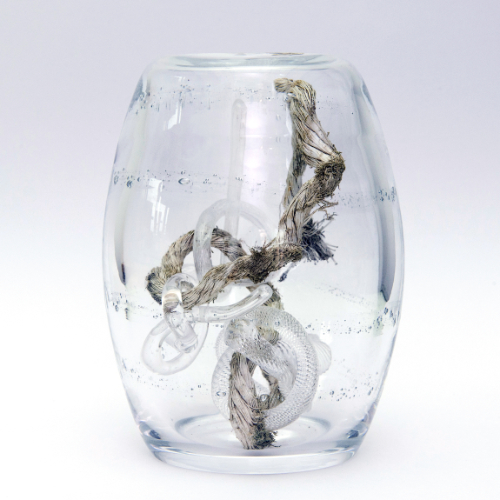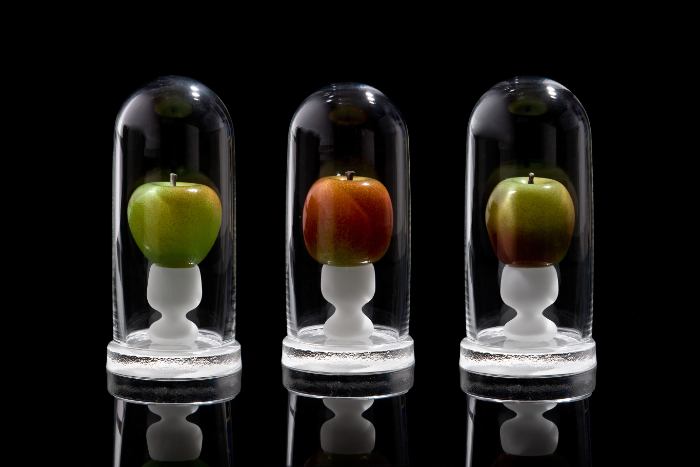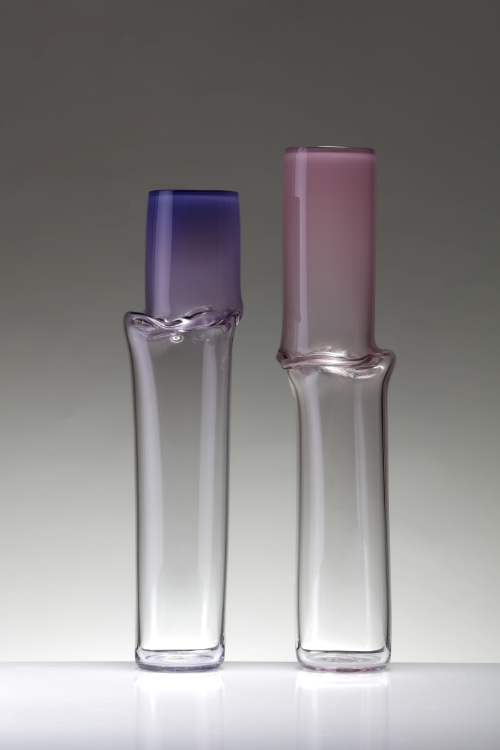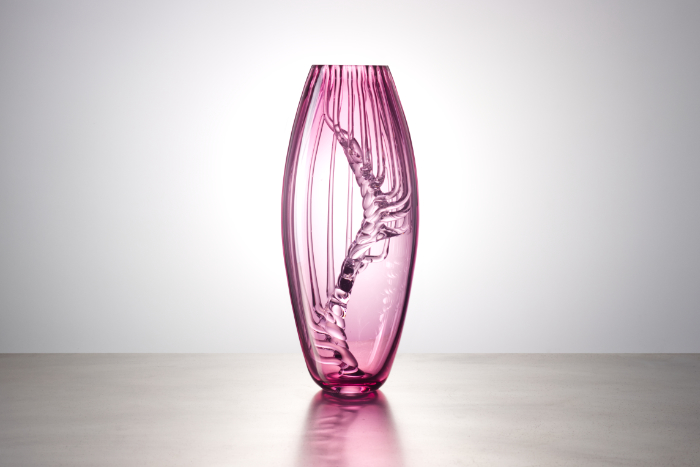
Glass artist interview with Emma Baker
Emma Baker’s love of glassblowing has taken her around the world to develop her practice. Her recent pieces focus on investigating the materiality of glass and she has recently set up her own studio space. Linda Banks finds out more.
What led you to start working with glass?
In 2010 I started on an Applied Arts course at Bournemouth University with the intention of becoming a silversmith or jewellery maker. The course was structured so that we worked with metals, clay and hot glass. We did sandcasting as our first introduction to hot glass which, if I’m completely honest, I wasn’t particularly interested in. However, six months later when we started learning the basics of glassblowing that was it, my desire to become a silversmith vanished and I was hooked by the challenges and allure of glassblowing.
What glass techniques have you used, and which do you prefer?
During my studies I was able to try many different glass techniques. I love the potential of coldworking glass and the visuals of cut glass, but I realised early on that I feel the cold too much to be in a coldworking studio. I prefer to work in 3D as opposed to stained glass or mosaic making, and the immediacy and characteristics of glassblowing are what make it my preference. However, I do enjoy the independence of kiln-forming and being able to put work in a kiln, leave the programme to run and see the result.
As time has passed and my relationship with glassmaking has evolved, I’m leaning towards more accessible forms of glassworking, like kiln work or engraving, as it provides a balance between being creative and life and work.

Please tell us more about your creative approach. Do you draw your ideas out or dive straight in with the materials?
My inspiration comes from experiences and memories. In my early works, I created objects in glass that featured my memories of loved ones. Often I used found objects to convey the narrative of the piece. I would sketch these works on paper first, playing around with composition and design before creating and assembling the final components. My more recent works have been based on experimenting with the material, seeing how it can, and wants to, behave. For these pieces I sketch more abstractly, focussing on colour combinations, scale or quantity. As these works are all about the material’s characteristics, they are created almost exclusively in the studio, since the finer details of the finished piece isn’t predetermined.
Do you have a favourite piece or collection you have made? Why is it your favourite?
Early on I created two works in the ‘Idiosyncrasies’ series. These are made in memory of my grandparents and celebrate objects that have a strong association to them. I was hugely focussed on prioritising narrative through my glass work at this point and these pieces allowed me to challenge my skills in glassblowing at the same time. Trying to make an apple in glass that actually looked like an apple definitely kept me on my toes.


As my work has evolved and I’ve become ever more focussed on how the material behaves, I really enjoy making the ‘Torsion’ works and the latest series I’m working on. These latest works challenge my glassblowing on a technical level but also celebrate the characteristics of the material.
Where do you show and sell your work?
I apply and take part in as many exhibitions as possible to showcase my work. I’ll look at any opportunity that gets the work out of the box and on show. They can be smaller, local exhibitions or larger scale events, like the British Glass Biennale. I aim for three exhibitions or shows a year and any more is a bonus. It’s always a treat to get an invite to show work, which saves on the application administration. Pieces from the ‘Torsion’ series are available through Vessel Gallery in London and all my works are shown on my website.

Where is your creative practice heading next?
Over the past six months I have been undertaking a residency at Sunderland University’s glass department as part of the AA2A programme, which provides artist residencies and professional practice development at various art and design institutions across England. This has given me the opportunity to delve into the experimentation and development of my ‘Flux’ series. It has also provided me with the support and security to explore and identify the values I enjoy in glassmaking, taking a step back from the demands and pressures of having to create and instead finding joy in the process again.

I am also one of four lucky recipients of the Contemporary Glass Society’s Amanda Moriarty prize, and I can’t wait to be at the Teign Valley Glass studio in May 2025. As I balance my creative practice with part-time work, these residency opportunities are invaluable. They allow me time to escape and submerge myself back into creativity alongside providing the facilities and support to create.
This last year has been full of momentum for me so it’s all about maintaining that as much as I can. I recently received an Honorary Diploma from the Jutta Cuny-Franz Foundation which is a huge recognition for me and is extremely exciting.
I’m currently setting up a studio space. It has no furnace or glassblowing facilities, but I have a small kiln in a space I can immerse and surround myself with ideas and inspiration. What’s next? Setting off my kiln for its first firing.
About the artist

Emma has worked with glass for over 10 years, initially encountering the material whilst studying Applied Arts at Bournemouth University, then moving on to receive her BA(hons) from Sunderland University in 2014.
Her passion for learning and understanding the material has driven her to work with an abundance of glassmakers in a variety of locations. In 2019 she became one of two Associate Artists at North Lands Creative, a two-year programme supporting and developing the practice of glass artists. She spent 2020 living and working in Bergen, Norway keeping the furnace alight at S12 Galleri og Verksted. In the summer of 2022, she was invited on an international glass exchange by the National Glas Museum in Leerdam, Holland, to create work that is now held in its public collection.
Emma has been awarded residencies at Berlin Glas, The Glass Factory, S12 Bergen and North Lands Creative.
Her work has been shown across the UK and Europe, including the Crafts Council’s Collect 2023, London. She has received scholarship funding to the US and has worked on international cross-cultural projects supported by British Council Scotland and Creative Europe. She has also been a teaching assistant at Corning Museum of Glass, Bild-Werk Frauenau and North Lands Creative.
Find out more about Emma Baker via her website: www.emmabakerglass.com and follow her on Instagram: @_emmbaker
Main feature image: ‘Flux Noir’ is one of Emma’s recent creations, made during her AA2A residency. Photo: Simon Bruntnell.
